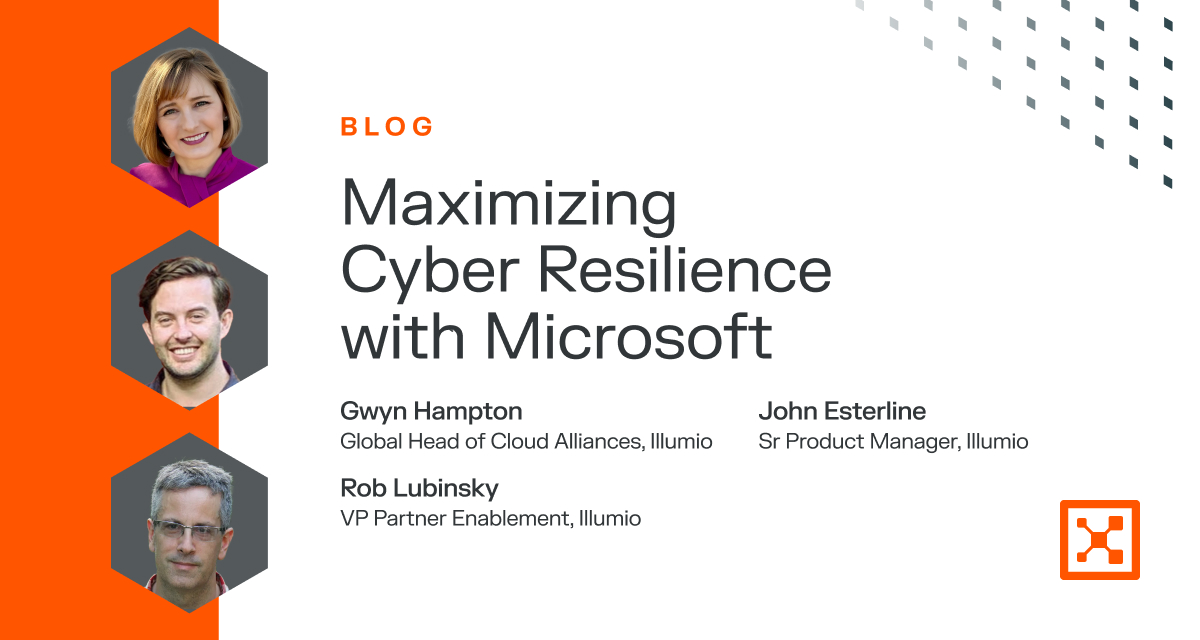Cloud Migration: A Guide to Seamless and Secure Cloud Adoption
What is cloud migration?
Cloud migration means moving your data, apps, and workloads from on-prem systems to the cloud — or even from one cloud provider to another. Companies make the move to scale faster, save money, and boost security.
At Illumio, we know cloud migration isn’t just about tech — it’s about transforming your security. Without the right protections, cloud moves can open the door to misconfigurations, unauthorized access, and fast-spreading threats. That’s why our solutions keep security front and center, every step of the way.
Why cloud migration matters
Moving from on-premises to the cloud isn’t just a trend — it’s a smart move. As the digital world moves fast, businesses need to keep up. Whether you’re big or mid-sized, cloud migration can boost performance, cut costs, and give you the flexibility to grow.
Key benefits of cloud migration:
- Scalability: Businesses no longer have to guess their future IT needs. With cloud services, they can scale resources up or down based on demand, ensuring optimal performance without overprovisioning.
- Cost efficiency: Moving to the cloud gets rid of the need for expensive on-premises hardware and maintenance. Organizations can shift from capital expenditures (CapEx) to an operational expense (OpEx) model, reducing upfront costs and enabling more predictable budgeting.
- Enhanced security: Cloud providers offer built-in security features such as encryption, identity management, and compliance certifications. When combined with Illumio Segmentation, businesses gain an additional layer of protection against cyber threats.
- Disaster recovery and business continuity: Cloud-based backup and disaster recovery solutions ensure that businesses can quickly recover from outages, cyberattacks, or natural disasters with minimal disruption.
- Performance optimization: Cloud providers have global data centers, ensuring low latency and high availability for applications. This translates into faster load times and a better user experience.
- Flexibility and remote access: Employees can securely access applications and data from anywhere, supporting a more mobile and remote workforce.
- Compliance and regulatory adherence: Cloud environments offer compliance controls that help organizations adhere to industry regulations such as GDPR, HIPAA, and SOC 2.
- Seamless integration with emerging technologies: Cloud migration enables businesses to leverage AI, machine learning, IoT, and advanced analytics without major infrastructure investments.
Cloud migration isn’t just about shifting to a new environment. It’s about transforming the way businesses operate and compete in an increasingly digital world. By embracing a well-structured cloud migration framework, organizations can future-proof their IT infrastructure while enhancing agility, security, and efficiency.
7 steps of cloud migration
Every successful cloud migration follows a structured approach. Here’s a high-level breakdown:
- Assessment and planning: Define goals, analyze current infrastructure, and evaluate workloads for migration.
- Choosing a cloud provider: Select from AWS Cloud Migration Services, Azure, Google Cloud, or hybrid solutions.
- Defining a cloud migration strategy: Determine whether to lift-and-shift, re-platform, or re-architect applications.
- Cloud data migration strategy: Ensure data integrity and security with encryption and segmentation.
- Testing and validation: Run tests to validate performance, security, and functionality in the new environment.
- Cutover and deployment: Execute the final migration with minimal downtime.
Optimization and security hardening: Monitor performance, fine-tune resources, and apply Zero Trust security principles.
Cloud migration strategies
Organizations adopt different cloud migration strategies based on their goals, workloads, and risk appetite. The five primary approaches are:
Cloud migration frameworks and security considerations
Cloud migration security challenges
Security remains a primary concern during cloud migration. Some key risks include:
- Misconfigurations: Cloud environments that aren’t configured correctly can expose sensitive data. Cloud infrastructure often has complex security settings. A single misconfiguration can lead to data breaches, unauthorized access, and compliance failures.
- Data breaches: Unauthorized access to cloud-stored information due to inadequate controls. Weak access controls, insecure APIs, and unencrypted data in transit or at rest make cloud environments prime targets for cybercriminals.
- Lateral movement of threats: Attackers exploiting vulnerabilities to spread across cloud environments. Once inside, bad actors can move laterally between workloads and services, escalating privileges and gaining deeper access to critical systems.
- Insecure third-party integrations: Many organizations leverage third-party cloud services, but these integrations can introduce security risks if not properly vetted or secured.
- Compliance and regulatory risks: Failing to meet compliance standards such as GDPR, HIPAA, or SOC 2 due to weak cloud security controls can lead to legal penalties and reputational damage.
- Visibility and monitoring gaps: Traditional security tools often struggle to provide clear visibility into cloud workloads, making it difficult to detect suspicious activities or potential vulnerabilities in real time.
Lack of consistent security policies: Managing security across hybrid or multi-cloud environments can be challenging, leading to inconsistencies in access controls, monitoring, and incident response.
How Illumio enhances cloud migration security
At Illumio, we address these challenges through segmentation and cloud workload security. Our approach ensures that even if an attacker gains access, they can’t move laterally within the network.
- Illumio Insights: Harnesses an AI security graph for an unparalleled view of your cloud attack surface. Detect attacks, close security gaps, and cut off attack paths with an AI cloud detection and response (CDR).
- Illumio Segmentation: Prevents unauthorized communication between workloads, even in cloud-native environments. By defining granular segmentation policies, Illumio ensures that cloud assets remain isolated from unauthorized access, mitigating risks associated with shared infrastructure.
- Automated security policies: Illumio’s solutions dynamically adjust security policies as workloads migrate to the cloud, ensuring that security posture remains consistent and effective across on-prem, hybrid, and public cloud environments.
- Regulatory compliance and governance: Illumio helps organizations align with compliance standards such as GDPR, HIPAA, and PCI-DSS by enforcing strong segmentation policies, monitoring workload interactions, and providing detailed security reports for audits.
- Scalability and performance optimization: Unlike traditional firewall-based security models, Illumio’s Zero Trust approach ensures that security policies scale effortlessly as businesses expand their cloud environments. This eliminates performance bottlenecks while maintaining strong security controls.
With Illumio’s cloud migration solutions, enterprises can mitigate security risks, maintain regulatory compliance, and accelerate their digital transformation while ensuring that security is an integral part of the cloud migration journey.
Public cloud migration vs. hybrid cloud approaches
Companies often weigh the advantages of public cloud migration versus hybrid cloud adoption:
- Public cloud migration: Complete transition to cloud providers like AWS, Azure, or GCP.
- Hybrid cloud migration: A mix of on-premises and cloud environments for flexibility and control.
At Illumio, we support both approaches by ensuring security policies are enforced consistently across cloud and on-premises environments.
How does Illumio secure cloud migration in its platform?
Illumio is deeply integrated into cloud migration processes by:
- Providing visibility into workloads before, during, and after migration. Through real-time traffic analysis and microsegmentation, Illumio helps organizations maintain clear visibility into their cloud environments, reducing the risk of blind spots.
- Applying microsegmentation to minimize attack surfaces. By enforcing segmentation, Illumio limits lateral movement within cloud environments, ensuring workloads remain isolated from unauthorized access.
- Ensuring Zero Trust security for hybrid and multi-cloud environments. Illumio seamlessly applies security policies across on-premises, hybrid, and multi-cloud infrastructures, ensuring consistent security postures.
- Helping enterprises secure their cloud workloads without disrupting operations. Illumio’s adaptive security policies dynamically adjust to workload changes, reducing the complexity of securing cloud migrations while maintaining operational efficiency.
Enhancing regulatory compliance and risk management. By providing detailed audit trails, workload-level visibility, and automated policy enforcement, Illumio helps organizations adhere to regulatory standards and manage security risks effectively.
Cloud migration frequently asked questions (FAQs)
Question: 1. What are the phases of cloud migration?
Answer: The cloud migration process typically consists of assessment, strategy development, planning, migration execution, testing, and optimization.
Question: 2. What is the best cloud migration strategy?
Answer: The ideal strategy depends on business goals, but lift-and-shift, re-platforming, and refactoring are the most common approaches.
Question: 3. What are AWS cloud migration services?
Answer: AWS offers a suite of services like AWS Migration Hub, Application Migration Service, and Database Migration Service to support cloud adoption.
Question: 4. How does cloud migration improve security?
Answer: Migrating to the cloud enables better security controls, encryption, segmentation, and real-time monitoring to reduce cyber risks.
Question: 5. How can Illumio help with cloud migration security?
Answer: Illumio ensures segmentation, workload security, and attack surface reduction during cloud transitions.
Question: 6. What is cloud-to-cloud migration?
Answer: It refers to moving workloads between different cloud providers, such as AWS to Azure or GCP to AWS.
Question: 7. What are common challenges in cloud data migration?
Answer: Data integrity, downtime risks, compatibility issues, and security concerns are major obstacles.
Question: 8. How long does cloud migration take?
Answer: Timelines vary based on workload complexity, but small migrations can take weeks while enterprise-wide transitions may span months.
Question: 9. What is the role of cloud migration planning?
Answer: Proper planning helps reduce downtime, mitigate risks, optimize costs, and ensure compliance.
Question: 10. What’s the difference between data center migration to cloud and cloud-native applications?
Answer: Data center migration moves existing applications to the cloud, while cloud-native applications are designed specifically for cloud environments.
Final thoughts
Cloud migration is a complex but necessary evolution for enterprises seeking scalability, flexibility, and security. At Illumio, we believe that security should be a foundational element — not an afterthought — in every cloud migration journey. By leveraging microsegmentation, and cloud workload security, organizations can safely migrate to the cloud without exposing themselves to unnecessary risks.
Need expert guidance on securing your cloud migration? Let’s talk.
.png)
%20(1).webp)

.webp)










.webp)





